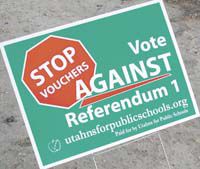The majority of Carbon County recently contacted by the Sun Advocate reported a negative outlook toward referendum one. But several local educators and private residents are making the case that parental choice takes precedent over changes in the public school funding structure.
Some Utah legislators, including Sen. Mike Dmitrich, have made their opinions clear in website postings and to the media, hoping to sway voters in November.
“Vouchers are not a bureaucrat and liberal union issue as has been cited by voucher proponents,” said Dmitrich in a web posting. “Instead, the core issue is whether or not it is in the best interest of our public education system to subsidize private schools. In my opinion, the voucher law is blatantly unfair to Utah’s students, particularly those who reside in rural areas of the state.”
Local educators have taken a similar stance on the issue.
“To me, the bottom line is that referendum one will take public money, meant for public schools and use it for private needs,” said Carbon District Superintendent Patsy Bueno.
It is Bueno’s contention that the referendum would be especially harmful to the district due to the nearly non-existent private school population in Carbon County.
“I think, if it passes, it will be devastating to public schools in our area,” said Bueno. “I have seen the commercials with the Oreos that show students being taken away and money continuing to come into public institutions while having smaller class size. But what those commercials fail to take into account is the fact that costs such as capital expenses, utilities, teachers’ salaries, benefits and debt service do not change for a public school because a few children leave.”
According to Utah’s voter information pamphlet, the parent choice in education program as outlined in referendum one provides annual, state funded scholarships for qualifying children to attend eligible private schools.
Scholarships under the proposed program range from $500 to $3,000 per student, depending on family size and income.
The scholarship amounts would be raised annually by the same percentage of the increase in public school per-student funding.
Under the proposed voucher program, school districts will be allowed to retain some per-student funding for scholarship recipients who transfer to private schools.
Parental choice concerning children’s education is the preeminent factor that has some Carbon County residents ready to vote for the referendum
“I think it gives parents a little more choice,” said Price resident Steve Wilkinson, whose daughter attends a local public school. “When you pay X amount of dollars in taxes every year, I feel that you deserve the right to have a say in how that money is spent.”
The principal of the county’s only private school has similar sentiments regarding the referendum issue.
“I feel, anytime you give people a choice, you create some competition. And in my mind, competition leads to better education. It makes schools more responsible and accountable to both parents and students,” said Southeastern Utah Christian Academy principal Fran Darter.
Darter has been a member of the academy staff for 26 years.
The local private school currently has 12 students, but the numbers have been as high as 40, according to Darter. The school charges $720 tuition per year and all instructors teach on a volunteer basis.
“We struggle financially and the vouchers would assist us, but we do fine with volunteer teachers. It means that they are here for the students, not for the paycheck,” said Darter. “We interview students and then decide about admittance. We never turn someone away based on finances.”
Bruin Point Elementary principal Melissa Hamilton sees things in a different light.
“This legislation will be particularly hurtful here in rural Utah,” said Hamilton. “Transportation costs are compounded in rural areas because of the distance between schools. If Referendum one passes and enough students transfer from our small public schools, it could lead to closures and that would be hugely expensive for our district.”
Disagreements between the opposing sides of referendum one show the complexity of the education issue, not just in the Carbon District but across Utah.
“Our daughter attends Pinnacle Canyon Academy and I have really been impressed with the amount of parental involvement they demand from the parents concerning their students,” said Wilkinson, who has an 9-year-old at the charter school. “The fact that we had a choice about our child’s education was very important to me and my wife.”
Wilkinson understands that money from the new legislation would not go to the local charter school if it passes. However it was his contention that choice and options concerning education were the dominant issue in this debate.
Choice is not the issue that Sen. Dmitrich argues is central to referendum one.
According to Dmitrich, the voucher legislation could cost Utah taxpayers as much as $429 million during the next 13 years as students in existing private schools qualify for subsidy.
“This education money will not go to public schools. To the contrary, after five years, public school funding will be reduced to reflect transfers to private schools regardless of the ability of impacted schools to reduce fixed costs. Depending upon enrollment patterns, some public schools would simply have to do more with less,” said Dmitrich.
The Senate minority whip also points to the voucher bill as a tool for creating a cultural division in Utah.
“Private schools will naturally arise from perceived academic superiority, social or economic status, religious preferences, lifestyle or political philosophy, undesirable student mix or a shared desire to be more exclusive,” explained Dmitrich. “Such schools have always existed, but not at taxpayer expense.”
Referendum debate fuels differing opinions in area

